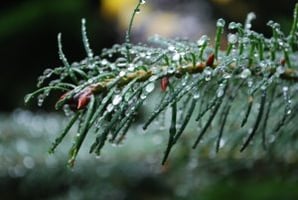Winter conditions offer many challenges to our gardens every year. Has your yard suffered from winter damage? Learn what to look out for, and what steps you can take to keep your garden looking its best, even in the harshest of winter conditions.

Winter Gardening – Problem Spotting
In St. Louis we experience snow, ice, dramatic freeze/thaw cycles, biting wind, and heavy salt use to melt snow and ice in winter. If you are experiencing any of these winter weather patterns, you may need to take action.
Harsh Winter Conditions for Plants – Freeze/Thaw Cycles
Problems can pop-up in any garden simply from normal winter weather patterns in the Midwest. Luckily, most of these challenges can be alleviated by selecting plants that are cold hardy in our growing zone – St. Louis (along with Missouri and Illinois) is in the central growing zone, or zone 6 – as well as suited to the area in your garden where they are being planted (sun, shade, soil conditions, etc.). Along with supporting biodiversity, sustainability, and providing for pollinators, native plants bring a natural advantage here compared to imported plants, tropical, or hybrid plants.
We typically recommend a native-forward approach to landscape design. Native plants provide a natural advantage to our climate, year-round. You’ll also see more diverse wildlife in your property with more diversity in your plantings, which can also include great performing cultivars and hybrids.
Ice – Damage from Ice Storms

While ice storms aren’t common in St. Louis, they do happen, sometimes causing a great amount of damage. When we do get ice, it’s important to keep safety in mind at all times. While you may be eager to check on your trees and plants, it’s best to allow the ice to melt naturally. You should remove any fallen trees or limbs that may be blocking your sidewalk or driveway, along with any that are hanging dangerously. If you are not comfortable or able to remove the debris safely, hire a professional to handle the job for you. Icy conditions make work like this extra hazardous, and should be handled with care.
Please take your safety seriously in any ice storm, and contact Quiet Village Landscaping for ice and snow removal services.
Bitter Cold Temperatures & Wind Chill
We’ve all seen a winter weather forecast that makes us shiver at the thought of a few days of biting cold temperatures. Here’s what we recommend for your garden.
Before the temperatures drop: If a few days of especially cold days are coming, an old bed sheet or other light fabric can be gently placed over non-dormant plants, to help protect them from the cold. Covering plants is meant to be a temporary solution, so make sure to remove the cover after a few days. All dormant plants can be left alone.
After the cold spell: Any brown foliage or broken branches can be removed. Otherwise, most plants can be left alone. Many perennial plants are root hardy, meaning the stems and foliage may be dead, but the plant will regrow from the root system. It’s best to resist the temptation to take action, and instead wait until new growth emerges so you can prune plant properly.
Salt Damage from Road & Walkway Treatments
Depending on snowfall and the amount of times your driveway, walkways, or roadways will get treated with salt, you may need to choose plants that can withstand a bit of salt in low-maintenance areas. In early spring, areas that were impacted heavily with salt can be flushed with water, to remove salts from the main root zone areas of the plants. This is why we choose a rock border and hard perennial plants for the high traffic roadside native garden we planted in Olivette last year. The landscape design keeps salt, oil, and other debris from the roadway away from plants, while establishing attractive native plants that perform well in unprotected conditions.
Winter Tree Damage
Heavy snowfall and ice can cause significant damage to tree branches. If accumulated snow is bending branches (big or small), you can gently knock the snow off. Ice should be left to melt naturally. Deep root feedings in winter can help trees survive through harsh winter temperatures.
If you have questions about a plant in your garden, or want to plan your gardens for long-term success and beauty, winter is a great time to work with a landscape designer or horticulturalist to assess your yard as-is, and to make recommendations for your property. That might involve new plantings in spring, removal of unwanted plants or elements in your yard, moving or rearranging plants, or doing a complete tear-out and regrading of your landscape. Take an inventory of your plants now, or work with an experienced landscaping professional to set your garden up for success for spring. We are proud to be a Grow Native member, helping to design natural beauty into every property we care for.


